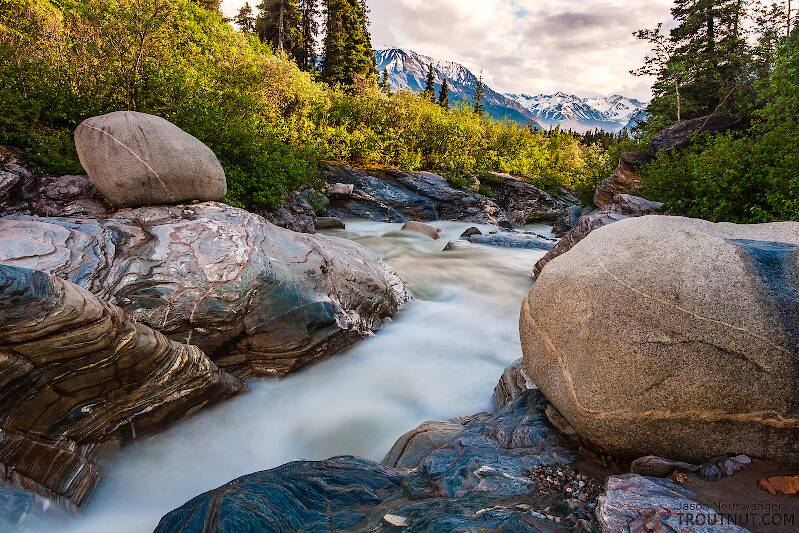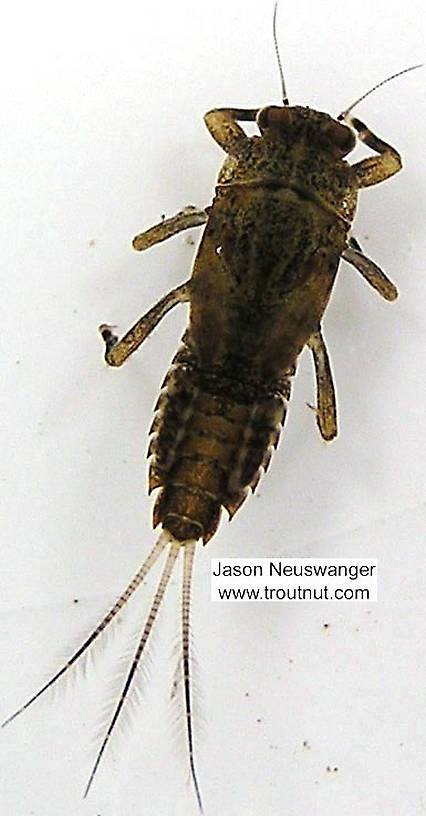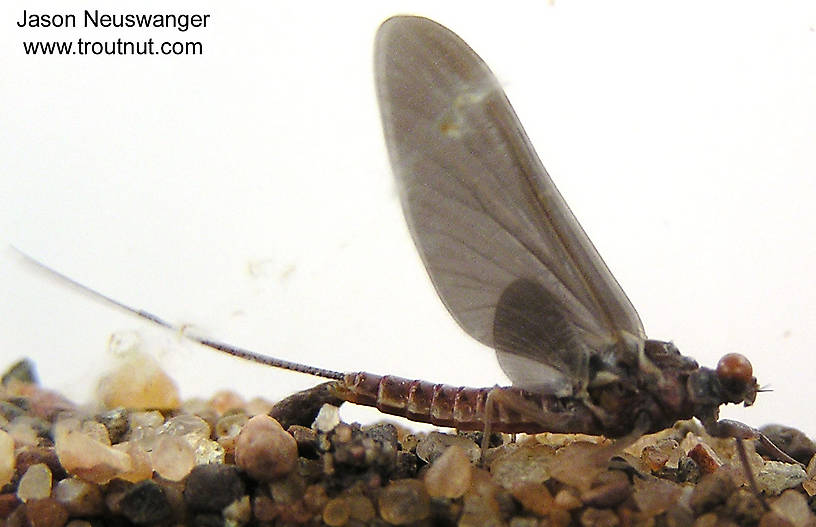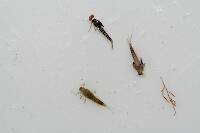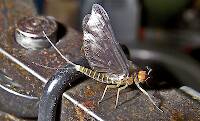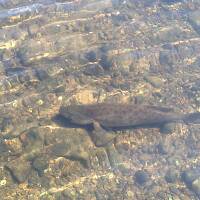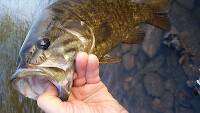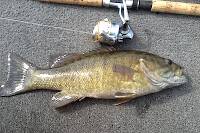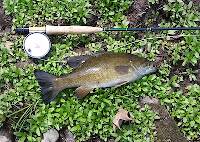
Salmonflies
Pteronarcys californica
The giant Salmonflies of the Western mountains are legendary for their proclivity to elicit consistent dry-fly action and ferocious strikes.
Featured on the forum

I was not fishing, but happened to be at an unrelated social event on a hill above this tiny creek (which I never even saw) when this stonefly flew by me. I assume it came from there. Some key characteristics are tricky to follow, but process of elimination ultimately led me to Sweltsa borealis. It is reassuringly similar to this specimen posted by Bob Newell years ago. It is also so strikingly similar to this nymph from the same river system that I'm comfortable identifying that nymph from this adult. I was especially pleased with the closeup photo of four mites parasitizing this one.

Troutnut is a project started in 2003 by salmonid ecologist Jason "Troutnut" Neuswanger to help anglers and
fly tyers unabashedly embrace the entomological side of the sport. Learn more about Troutnut or
support the project for an enhanced experience here.
This topic is about the Mayfly Species Ephemerella subvaria
The Hendrickson hatch is almost synonymous with fly fishing in America. It has been romanticized by our finest writers, enshrined on an untouchable pedestal next to Theodore Gordon, bamboo, and the Beaverkill.The fame is well-deserved. Ephemerella subvaria is a prolific species which drives trout to gorge themselves. Its subtleties demand the best of us as anglers, and meeting the challenge pays off handsomely in bent graphite and screaming reels.
Example specimens
TheMidge on May 10, 2007May 10th, 2007, 9:05 am EDT
I was hoping I could get a little info on what effects a Hatch. Air Temp? Water Temp? A combination? I'm trying to determine the best time to catch a hatch on stream near me, as I have a small window to fish in on a short trip home. I am expecting to see Hendrickson's, as it's the right time of year (or so I have been told) for this stream. What's the best way to guess?
Taxon on May 10, 2007May 10th, 2007, 1:46 pm EDT
Dave-
According to available literature, when water temperature reaches the mid 40’s, sporadic Hendrickson (Ephemerella subvaria) emergence will occur. However, water must reach the 50-55 degree range to trigger prolific emergence. Peak emergence activity normally starts sometime between mid-April and early-May, and lasts for 2-3 weeks. Peak emergence activity normally lasts for several hours, starting in the early afternoon. In unusually hot weather, emergence can be delayed until the sun is off the water.
The nymphs are found in both slow and fast water, but they display an aversion to areas subjected to temperature extremes. As a result, few are found in cold headwater streams or in warm slack-water stretches of rivers. When preparing to emerge, the mature nymph migrates to slower current. It will then make several trips to the surface, employing an exaggerated wiggling motion, before finally escaping its nymphal shuck at or just below the water’s surface.
In cool weather, the dun can be tantalizingly available to trout as it floats a good distance downstream while drying its wings. With the arrival of warmer weather and more prolific hatches, trout will increasingly feed on the dun, and at times with seemingly reckless abandon.
According to available literature, when water temperature reaches the mid 40’s, sporadic Hendrickson (Ephemerella subvaria) emergence will occur. However, water must reach the 50-55 degree range to trigger prolific emergence. Peak emergence activity normally starts sometime between mid-April and early-May, and lasts for 2-3 weeks. Peak emergence activity normally lasts for several hours, starting in the early afternoon. In unusually hot weather, emergence can be delayed until the sun is off the water.
The nymphs are found in both slow and fast water, but they display an aversion to areas subjected to temperature extremes. As a result, few are found in cold headwater streams or in warm slack-water stretches of rivers. When preparing to emerge, the mature nymph migrates to slower current. It will then make several trips to the surface, employing an exaggerated wiggling motion, before finally escaping its nymphal shuck at or just below the water’s surface.
In cool weather, the dun can be tantalizingly available to trout as it floats a good distance downstream while drying its wings. With the arrival of warmer weather and more prolific hatches, trout will increasingly feed on the dun, and at times with seemingly reckless abandon.
Troutnut on May 10, 2007May 10th, 2007, 4:23 pm EDT
Hendricksons have been coming off pretty well here in upstate NY this year. They can come anytime in the afternoon or evening, but as a general rule they'll come in the evening on cold days and earlier in the afternoon on warm days. That's mostly because of the water temperature, but Hendricksons are generally though to prefer cloudy weather when they can find it, too.
Jason Neuswanger, Ph.D.
Troutnut and salmonid ecologist
Troutnut and salmonid ecologist
GONZO on May 13, 2007May 13th, 2007, 5:11 am EDT
The Midge--I just wanted to offer a few additions to the comments Roger and Jason made about Hendricksons.
Roger is correct that Hendricksons may hatch for 2-3 weeks in a region or watershed, but that may give a mistaken impression about the actual length of the hatch in a given stretch of stream. On a particular section of water, the significant hatching will usually last for about 5-7 days. Because most streams become colder as one moves toward the headwaters, most hatches progress upstream, hatching first in the warmer lower water and later in the colder higher water. Of course, stream areas that are influenced by large cold feeders (such as a spring creek) or tailwater sections can be on a different schedule than the rest of the stream or river.
Timing the daily emergence can be tricky when water temperatures are not normal for the time of year. (But, what is "normal" about our weather lately?) Hendricksons (like most hatches) seem to have a preferred or optimum water temperature for emergence and the best hatching usually occurs when the water temperature makes the greatest movement toward the ideal. This means that during cool spring weather with cold water (water temp. 45-50 degrees) the best hatching happens when water temperature approaches its daily high (often around 3-4 pm). When the weather and water are warm (water temp. 55-60 degrees), the hatch is usually pushed to the evening (often 5-7 pm), although extremely warm conditions might also create sporadic emergence in the morning. On spring creeks or tailwaters with more stable temperature regimes or when stream temps are between the extremes (water temp. in mid-fifties), one often sees a reliable emergence from 1 to 3 pm. Spinner falls are usually an early evening to late-evening affair, although unusually hot weather can push them to the mornings.
I highly recommend that hatch-seeking anglers carry a small pocket nymph seine (very easy to make). This will allow you to quickly check the status of the nymph population on sections that you wish to fish. For example, if your samples turn up good numbers of Hendrickson nymphs, but few or none are mature (mature nymphs have dark wingcases, although this is a little hard to see with some of the darker-colored Hendrickson nymphs), you are too early for significant hatching. If mature Hendrickson nymphs are in the majority in the samples, it's a good bet that you'll see hatching over the next few days. If you turn up only a few mature nymphs and no immature nymphs, then the peak of the hatch has probably passed in that stretch, and you should search farther upstream or hope that the spinners are still available in the evening. Of course, no nymphs in multiple samples usually means no hatch (although it is worth mentioning that some streams are harder to sample than others, and some are richer than others).
Keep in mind that many Eastern streams have overlapping hatches of blue quills, quill Gordons, Baetis, and caddisflies like grannoms, little black sedges and others around Hendrickson time. If your search for Hendricksons doesn't pan out, perhaps one of the others will be the hatch to match.
Best,
Gonzo
Roger is correct that Hendricksons may hatch for 2-3 weeks in a region or watershed, but that may give a mistaken impression about the actual length of the hatch in a given stretch of stream. On a particular section of water, the significant hatching will usually last for about 5-7 days. Because most streams become colder as one moves toward the headwaters, most hatches progress upstream, hatching first in the warmer lower water and later in the colder higher water. Of course, stream areas that are influenced by large cold feeders (such as a spring creek) or tailwater sections can be on a different schedule than the rest of the stream or river.
Timing the daily emergence can be tricky when water temperatures are not normal for the time of year. (But, what is "normal" about our weather lately?) Hendricksons (like most hatches) seem to have a preferred or optimum water temperature for emergence and the best hatching usually occurs when the water temperature makes the greatest movement toward the ideal. This means that during cool spring weather with cold water (water temp. 45-50 degrees) the best hatching happens when water temperature approaches its daily high (often around 3-4 pm). When the weather and water are warm (water temp. 55-60 degrees), the hatch is usually pushed to the evening (often 5-7 pm), although extremely warm conditions might also create sporadic emergence in the morning. On spring creeks or tailwaters with more stable temperature regimes or when stream temps are between the extremes (water temp. in mid-fifties), one often sees a reliable emergence from 1 to 3 pm. Spinner falls are usually an early evening to late-evening affair, although unusually hot weather can push them to the mornings.
I highly recommend that hatch-seeking anglers carry a small pocket nymph seine (very easy to make). This will allow you to quickly check the status of the nymph population on sections that you wish to fish. For example, if your samples turn up good numbers of Hendrickson nymphs, but few or none are mature (mature nymphs have dark wingcases, although this is a little hard to see with some of the darker-colored Hendrickson nymphs), you are too early for significant hatching. If mature Hendrickson nymphs are in the majority in the samples, it's a good bet that you'll see hatching over the next few days. If you turn up only a few mature nymphs and no immature nymphs, then the peak of the hatch has probably passed in that stretch, and you should search farther upstream or hope that the spinners are still available in the evening. Of course, no nymphs in multiple samples usually means no hatch (although it is worth mentioning that some streams are harder to sample than others, and some are richer than others).
Keep in mind that many Eastern streams have overlapping hatches of blue quills, quill Gordons, Baetis, and caddisflies like grannoms, little black sedges and others around Hendrickson time. If your search for Hendricksons doesn't pan out, perhaps one of the others will be the hatch to match.
Best,
Gonzo
TheMidge on May 15, 2007May 15th, 2007, 4:20 am EDT
It's interesting to me that so many "New England" Hatch charts call out specific time frames and dates for the area of New England. I think what they really mean to say is "New York and Conn." My yearly week long trip to Grand Lake Stream, and I know for sure that the Hendrickson's may not even begin to hatch until next weekend. I'm good with that, though:) Should be a great week, before the crowds show up
GONZO on May 15, 2007May 15th, 2007, 4:48 am EDT
Yeah, hatch charts are a general reference at best and meaningless at worst. Latitude, altitude, water temperature differences, and weather trends all have a tremendous influence on hatch timing. And early season hatches are always subject to more timing variation than hatches that occur closer to mid-season. There is no substitute for local knowledge and intimacy with a particular stream.
Greenghost on May 16, 2007May 16th, 2007, 4:31 pm EDT
quote/There is no substitute for local knowledge and intimacy with a particular stream/unquote
amen.
amen.
GONZO on May 17, 2007May 17th, 2007, 7:50 am EDT
Hi Greenghost,
I can already tell from your posts that you have a very intimate and cherished connection to your homewaters. Louis recently mentioned to me that he was surprised at how these waters can attach themselves to one's heart. Personally, I wouldn't trade my relationships with my homewaters for all the famous and glamorous fly-fishing destinations in the world! (I'm sure you feel the same way.)
Best,
Lloyd
I can already tell from your posts that you have a very intimate and cherished connection to your homewaters. Louis recently mentioned to me that he was surprised at how these waters can attach themselves to one's heart. Personally, I wouldn't trade my relationships with my homewaters for all the famous and glamorous fly-fishing destinations in the world! (I'm sure you feel the same way.)
Best,
Lloyd
Greenghost on May 26, 2007May 26th, 2007, 11:36 am EDT
Gonzo,
I sure wouldn't pass up the chance to see and fish the famous rivers that I've only read about,but you're right,there's no place like home.Then again,some of my homewaters actually ARE world class Atlantic Salmon rivers.
I sure wouldn't pass up the chance to see and fish the famous rivers that I've only read about,but you're right,there's no place like home.Then again,some of my homewaters actually ARE world class Atlantic Salmon rivers.
Quick Reply
Related Discussions
Topic
Replies
Last Reply
14
Aug 16, 2015
by Catskilljon
by Catskilljon
I agree with the nymph and emergence coments above
In the Mayfly Species Litobrancha recurvata by Beardius
In the Mayfly Species Litobrancha recurvata by Beardius
0
Aug 1, 2008
by Beardius
by Beardius
4
Jun 18, 2018
by Adirman
by Adirman

